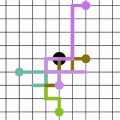Trading styles can be classified into either trend-following or mean-reverting. If the net trading style is trend-following the traded asset is more likely to move in the same direction it moved previously (the opposite is true if the net style is mean-reverting). The result of this is to introduce positive (or negative) correlations into the time series. We here explore the effect of these correlations on the long-run variance of the series through probabilistic models designed to explicitly capture the direction of trading. Our theoretical insights suggests that relative to random walk models of asset prices the long-run variance is increased under trend-following strategies and can actually be reduced under mean-reversal conditions. We apply these models to some of the largest US stocks by market capitalisation as well as high-frequency EUR/USD data and show that in both these settings, the ability to predict the asset price is generally increased relative to a random walk.
翻译:贸易样式可以分为趋势追逐或平均反转。 如果净贸易样式是随交易资产趋势转动的趋势,则交易资产更可能沿着先前移动的同一方向移动(如果净样式是平均反转,则情况相反 ) 。 结果是在时间序列中引入正(或负)相关关系。 我们在这里通过旨在明确反映交易方向的概率模型来探索这些关联对系列长期差异的影响。 我们的理论见解表明,相对于资产价格随机走动模型而言,长期差异在遵循趋势的战略下增加,在平均反转条件下实际上可以减少。 我们通过市场资本化和高频欧元/美元数据将这些模型应用于一些最大的美国股票,并表明在这两种情况下,资产价格预测能力通常比随机走动增加。




